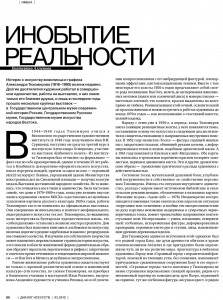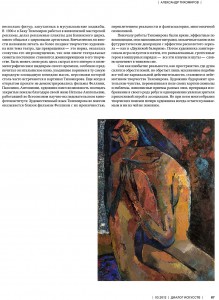Ekaterina Allenova
“DI” magazin #4, 2012
It hasn’t been long ago when the public sparked interest to works of the painter and graphic artist Alexander Tikhomirov (1916–1995). Over long decades the artist has been working in absolute solitude, without displaying any of his works, known only to his closest friends, and it was only during the latest years when he had few large exhibitions – at the State Central Museum of Modern History of Russia, the State Russian Museum and the State Museum of Oriental Art.
In 1944–1948 Tikhomirov studied at Moscow State Art Institute (named after V.I. Surikov in 1948), having at once been admitted to the third year of study into the workshop of Alexander Osmyorkin, formerly involved in exhibitions of the «Jack of Diamonds». However, he did not graduate from the institute, being expelled for «formalism» – biographical fact, which in itself proves how distant was Tikhomirov from Soviet art of the «socialistic realism» period. At that, he spent over 25 years working at the Decorative Art Concern, painted the portraits of leaders, one of which – huge (42 x 22 m) portrait of Lenin, used for decoration of the building of the Ministry of Foreign affairs on Smolenskaya square – has been awarded with the medal of the Exhibition of National Economy Achievements. However, those paintings which he created on the quiet and all by himself were so «different» that even in 1970–1980s, when artists of the «left Moscow Regional Union of Artists» started openly exhibiting their works and creations of the Russian avant-garde of 1920s were taken out of the basements, it was extremely unlikely that Tikhomirov’s works will ever appear on any official exhibitions. At that, neither did they match the context of unofficial, underground art of those years, with scandalous «Bulldozer exhibition» of 1974 and private home exhibitions arranged by merry and venturous art youth. As it seems, Tikhomirov had little interest in rebellious art life outside his workshop. His «companions» were the greatest artists of the past. House of the artist was filled with art books and albums, including expensive and rare foreign editions with excellent reproductions. And review of his own art could remind us of going through the pages of art history, and his search in the art field in a remarkable manner creates parallels, intertwinings and rhymes with the world’s art movements and trends which were banned during the Soviet times –from Van Gogh to Matisse, from cubism to expressionism.
Erly paintings of the artist did not only demonstrate «firm realistic background and pictorial culture» (according to Tikhomirov himself, he acquired these qualities at Baku college, where he has studies at the workshop of Ilya Ryzhenko, Art Academy graduate and one of Repin’s students) but his passion for impressionism with its vibrating texture, plain-air effects and colourful shades. At the same time, some of his canvas dated back to 1950s are kind of dedication to Van Gogh, up to quotation of scenic motives (boats or sun disc) and painting style – so thick that it looks like the paint has been squeezed onto canvas straight from the tube. Reminiscences of this fleshy, full of blare of colours art can be met in the artist’s works up to the end of the 1970s – as a memory of happy young years, full of hopes.
At the same time, already in the 1950s, – a period, when he was creating radiant multicoloured canvas, – Tikhomirov starts addressing themes laying a basis of his art for the following twenty years and pointing at dramatic internal search. In 1952 he creates «Anguish» – a figure of a sitting woman with her eyes closed, her arms wrapped around her knees, deformed body and a face of archaic mask. And in 1961 he creates similar painting «Magdalina». Both paintings are made in disturbing brown-red colours, by harsh, nervous movement of the brush. Where do they come from and how do these and other dramatic images appear in the head of seemingly happy artist? Apparently, it’s a reaction to tragic dissonance with reality – response of a man thrown into the life which is full of lies.
As of then state of anguish, painful heartache, deep absorbtion into their own «self» becomes unchangeable feature of Tikhomirov’s characters. Sometimes such situations of internal solitude and conflict with the world are inspired by biblic and evangelic reminiscencies, reflected in the titles of the paintings: «Expulsion from heaven», «Adam» (both created in 1978). He also repeatedly reproduces the situation of «mockery» or «pillory» which also have evangelic parallels. In fact, these virtually expressionistic paintings, created in steadily gloomy black and brown tones, carry on extremely heavy contextual field. Their characters – a prisoner, an exile, an outcast – are bent, twisted figures with primitivistically deformed proportions, with enormous hands and feet and faces reminding us of old wooden idols.
As such, referral to the ancient strata of consciousness is typical for avangardism, tending to deviate from realisticaly credible image of life –archaicism of artistic language by turning towards ancient cultures, including africal and oriental art. One of the sources of such «archaics» for Tikhomirov has been his hometown Baku, where spirits of the old days dwelled at the fire temple Ateshgah and where all the religions of the world mixed in the most bizzar manner. Architecture in the artist’s landscapes «City» or «Strange city», with amazing cinder-like texture, undoubtedly reminds us of medieval Baku and its suburbs. These bizarre Tikhomirov’s cities are often inhabited but not least weird characters: sleeping Harlequin, by his side – his eternal commedia dell’arte partner Pierrot playing the violin; here we also see bow backed figure carrying the cross, and nearby – few figures wrapped in muslim hijabs. In 1930s Tikhomirov worked at visual propaganda art workshop, making posters for the circus of Baku and spending lots of time in a company of circus artists. What was it that was in tune with his life views – impressions of his younger years or the theme of the theatre, where truth is so closely interlinked with falsity – this way or the other theatric scenes began dominating in Tikhomirov’s art. Maybe it was due to the fact that he was well acquainted with many cinema masterpieces of his time, giving special preference to Italian cinema deriving from the very street «mask comedies», characters of which can so often be seen in Tikhomirov’s paintings. Already in those times when it was impossible to see Fellini, Pazolini or Antonioni in public broadcast, the artist had a possibility to attend closed views thanks to his wife Natalya Anatolyevna, who worked at All-Union Scientific-Research Cinema and Photo Institute. Federico Fellini was one of Tikhomirov’s favourite film directors, obviously having very similar life views – we can recall, for example, «The Road» (1954), film-parable about vagrant circus artists. Films of the famous Italian film director, with their irony, reality interweaving with phantasmagoria and multivalent symbolics are from artistic language point of view in many respects close to Tikhomirov’s works on theatric themes.
Initially these were bright, dramatic compositions looking like a stained-glass panels, mosaic pannoes or futuristic decorations with broken mirror effect – like in «Double-Faced Ballet Dancer». Later on – a play of siluettes and stains, flowing into painted, grotesquely disguisting faces and glare costumes of the actors, clowns and bufoons, freezing in a heavy dream.
Dream as the otherness of reality, a space where soul tries to find peace, but finds only deformed kind of the same carnival reality – is one more leitmotif of Tikhomirov’s art. To be more precise, it’s a whole lot of leitmotives – from Hamlet’s questions about visions which will appear in a death dream, and up to famous «Night» of Michelangelo, beseeching from the mouth of the sculptor himself: «Be quiet, please, dare not awakening me» from the slumber of mind, creating monsters and up to phantasmagories of surrealism.
Like a bufoon in Shakespear’s tragedies, representing a wiseman under the mask of absurd, the artist tickles spectator’s feelings by mixing these leitmotives of the world culture, simbols and emplems, pictorial methods of different times on his canvas, by turning image into sort of a puzzle and at the same time attracting spectator’s interest by whimsical associations game. And, notwithstanding richness and variety of styles he remains recongnisable and always like no other.

